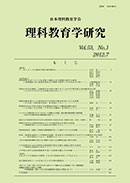Volume 53, Issue 1
Displaying 1-16 of 16 articles from this issue
- |<
- <
- 1
- >
- >|
Review Paper
-
2012 Volume 53 Issue 1 Pages 1-12
Published: July 17, 2012
Released on J-STAGE: June 30, 2021
Download PDF (1372K)
Original Papers
-
2012 Volume 53 Issue 1 Pages 13-27
Published: July 17, 2012
Released on J-STAGE: June 30, 2021
Download PDF (8156K) -
2012 Volume 53 Issue 1 Pages 29-38
Published: July 17, 2012
Released on J-STAGE: June 30, 2021
Download PDF (911K) -
2012 Volume 53 Issue 1 Pages 39-48
Published: July 17, 2012
Released on J-STAGE: June 30, 2021
Download PDF (1048K) -
2012 Volume 53 Issue 1 Pages 49-59
Published: July 17, 2012
Released on J-STAGE: June 30, 2021
Download PDF (3240K) -
2012 Volume 53 Issue 1 Pages 61-67
Published: July 17, 2012
Released on J-STAGE: June 30, 2021
Download PDF (11608K) -
2012 Volume 53 Issue 1 Pages 69-80
Published: July 17, 2012
Released on J-STAGE: June 30, 2021
Download PDF (1311K) -
2012 Volume 53 Issue 1 Pages 81-92
Published: July 17, 2012
Released on J-STAGE: June 30, 2021
Download PDF (1452K) -
2012 Volume 53 Issue 1 Pages 93-104
Published: July 17, 2012
Released on J-STAGE: June 30, 2021
Download PDF (1454K) -
2012 Volume 53 Issue 1 Pages 105-121
Published: July 17, 2012
Released on J-STAGE: June 30, 2021
Download PDF (1835K) -
2012 Volume 53 Issue 1 Pages 123-132
Published: July 17, 2012
Released on J-STAGE: June 30, 2021
Download PDF (5073K) -
2012 Volume 53 Issue 1 Pages 133-145
Published: July 17, 2012
Released on J-STAGE: June 30, 2021
Download PDF (1573K) -
2012 Volume 53 Issue 1 Pages 147-153
Published: July 17, 2012
Released on J-STAGE: June 30, 2021
Download PDF (8601K)
Note
-
2012 Volume 53 Issue 1 Pages 155-162
Published: July 17, 2012
Released on J-STAGE: June 30, 2021
Download PDF (8230K) -
2012 Volume 53 Issue 1 Pages 163-168
Published: July 17, 2012
Released on J-STAGE: June 30, 2021
Download PDF (8614K) -
2012 Volume 53 Issue 1 Pages 169-180
Published: July 17, 2012
Released on J-STAGE: June 30, 2021
Download PDF (1446K)
- |<
- <
- 1
- >
- >|
